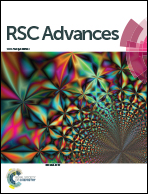A facile label-free colorimetric aptasensor for ricin based on the peroxidase-like activity of gold nanoparticles†
Abstract
AuNPs possess peroxidase-like activity that could catalyze 3,3,5,5-tetramethylbenzidine (TMB) in the presence of H2O2, leading to color change of the solution. Herein we propose a simple and sensitive colorimetric aptasensor for the quantitative analysis of ricin by using AuNPs. It is shown that the peroxidase-like activity of AuNPs can be improved by surface activation with target-specific aptamers. However, with target molecules, the aptamer is desorbed from the AuNPs' surface, resulting in a decrease of the catalytic abilities of AuNPs. The color change of the solution was relevant to the target concentration, and this can be judged by the naked eye and monitored by UV-vis spectrometry. The linear range for the current analytical system was from 0.05 nM to 10 nM. The corresponding limit of detection (LOD) was 0.05 nM. Some other proteins such as thrombin (Th), glucose oxidase (GOx), and bovine albumin (BSA) all had a negligible effect on the determination of ricin. What is more, several practical samples spiked with ricin were analyzed using the proposed method with excellent recoveries. This colorimetric aptasensor is superior to the other conventional methods owing to its simplicity, low cost, and high sensitivity.


 Please wait while we load your content...
Please wait while we load your content...